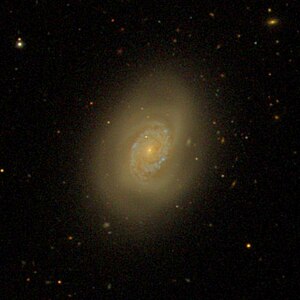NGC 4580
| Galaxy NGC 4580 |
|
|---|---|

|
|
| SDSS recording | |
| AladinLite | |
| Constellation | Virgin |
|
Position equinox : J2000.0 , epoch : J2000.0 |
|
| Right ascension | 12 h 37 m 48.4 s |
| declination | + 05 ° 22 ′ 07 ″ |
| Appearance | |
| Morphological type | SAB (rs) a / pec / LINER |
| Brightness (visual) | 11.8 mag |
| Brightness (B-band) | 12.3 mag |
| Angular expansion | 2.1 'x 1.5' |
| Position angle | 165 ° |
| Surface brightness | 13.0 mag / arcmin² |
| Physical data | |
| Affiliation | Virgo cluster Messier 49 group NGC 4343 group NGC 4636 group LGG 292 |
| Redshift | 0.003449 ± 0.000023 |
| Radial velocity | 1034 ± 7 km / s |
|
Stroke distance v rad / H 0 |
(43 ± 3) x 10 6 ly (13.2 ± 0.9) Mpc |
| history | |
| discovery | William Herschel |
| Discovery date | February 2, 1786 |
| Catalog names | |
| NGC 4580 • UGC 7794 • PGC 42174 • CGCG 042-183 • MCG + 01-32-117 • IRAS 12352 + 0538 • 2MASX J12374839 + 0522063 • VCC 1730 • GC 3122 • H I 124 • h 1369 • GALEX ASC J123748.32 +052205.5 • LDCE 904 NED206 | |
NGC 4580 is a bar-spiral galaxy with an active nucleus of the Hubble type SBa / P in the constellation Virgo north of the ecliptic . It is estimated to be 43 million light years from the Milky Way and about 25,000 light years across. It is listed as a member of the Virgo galaxy cluster under catalog number VCC 1730 .
The galaxies NGC 4543 and NGC 4577 are located in the same area of the sky .
The object was discovered on February 2, 1786 by the astronomer Wilhelm Herschel with the help of his 18.7 inch reflector telescope.
